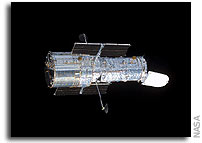NASA Hubble Space Telescope Daily Report #4250

HUBBLE SPACE TELESCOPE DAILY REPORT # 4250
– Continuing to collect World Class Science
PERIOD COVERED: UT November 30, 2006 (DOY 334)
OBSERVATIONS SCHEDULED
ACS/WFC 10521
ACS Imaging of a Unique Spitzer Field: Morphology of mid-IR Variable Sources
We propose to observe the IRAC Dark Field, an extragalactic field 15 arcminutes in diameter near the north ecliptic pole, using 50 orbits of ACS imaging at I-band. This field is extraordinarily deep and is uniquely suited to detecting variable objects in the mid-infrared. The high spatial resolution ACS imaging will be used to derive morphological information about the galaxies in the field, which will then be correlated with mid-infrared variable objects {specifically AGN and supernovae} we have discovered. This field is the dark current calibration target for the Spitzer Space Telescope, the infrared counterpart to HST. Because the field is observed frequently as part of routine operations, it is now similar in size and depth to the infrared component of the GOODS program, and is confusion-limited in the mid-infrared. More importantly, due to the periodicity of the observations, the Spitzer observations are sensitive to variability on week timescales, ultimately spanning a baseline of five years, and are the only mid-infrared dataset that will ever have this capability at this depth. By complementing our wide range of lower resolution imaging at optical and infrared wavelengths, we hope to exploit one of HST’s most unique capabilities – unparalleled spatial resolution in the optical. While our specific interest lies in analysis of variable sources, we will request no proprietary period on the ACS data so that it may be used by the community to complement the publicly available Spitzer data.
NIC1/NIC2/NIC3 8794
NICMOS Post-SAA calibration – CR Persistence Part 5
A new procedure proposed to alleviate the CR-persistence problem of NICMOS. Dark frames will be obtained immediately upon exiting the SAA contour 23, and every time a NICMOS exposure is scheduled within 50 minutes of coming out of the SAA. The darks will be obtained in parallel in all three NICMOS Cameras. The POST-SAA darks will be non-standard reference files available to users with a USEAFTER date/time mark. The keyword ‘USEAFTER=date/time’ will also be added to the header of each POST-SAA DARK frame. The keyword must be populated with the time, in addition to the date, because HST crosses the SAA ~8 times per day so each POST-SAA DARK will need to have the appropriate time specified, for users to identify the ones they need. Both the raw and processed images will be archived as POST-SAA DARKSs. Generally we expect that all NICMOS science/calibration observations started within 50 minutes of leaving an SAA will need such maps to remove the CR persistence from the science images. Each observation will need its own CRMAP, as different SAA passages leave different imprints on the NICMOS detectors.
NIC2, ACS/WFC 10802
SHOES-Supernovae, HO, for the Equation of State of Dark energy
The present uncertainty in the value of the Hubble constant {resulting in an uncertainty in Omega_M} and the paucity of Type Ia supernovae at redshifts exceeding 1 are now the leading obstacles to determining the nature of dark energy. We propose a single, integrated set of observations for Cycle 15 that will provide a 40% improvement in constraints on dark energy. This program will observe known Cepheids in six reliable hosts of Type Ia supernovae with NICMOS, reducing the uncertainty in H_0 by a factor of two because of the smaller dispersion along the instability strip, the diminished extinction, and the weaker metallicity dependence in the infrared. In parallel with ACS, at the same time the NICMOS observations are underway, we will discover and follow a sample of Type Ia supernovae at z > 1. Together, these measurements, along with prior constraints from WMAP, will provide a great improvement in HST’s ability to distinguish between a static, cosmological constant and dynamical dark energy. The Hubble Space Telescope is the only instrument in the world that can make these IR measurements of Cepheids beyond the Local Group, and it is the only telescope in the world that can be used to find and follow supernovae at z > 1. Our program exploits both of these unique capabilities of HST to learn more about one of the greatest mysteries in science.
FLIGHT OPERATIONS SUMMARY:
Significant Spacecraft Anomalies: (The following are preliminary reports of potential non-nominal performance that will be investigated.)
HSTARS:
10533 – GSacq(1,3,1) results in fine lock backup During LOS Gsacq(1,3,1) scheduled at 335/06:59:11 resulted in fine lock backup (1,0,1) due to receiving a stop flag QF3STOPF on FGS 3. The Map at 07:06:49 showed errors of V1=0.52, V2=-5.88, V3=-0.51, and RSS=5.93.
COMPLETED OPS REQUEST: (None)
COMPLETED OPS NOTES: (None)
SCHEDULED SUCCESSFUL
FGS GSacq 08 08
FGS REacq 07 07
OBAD with Maneuver 30 30
SIGNIFICANT EVENTS: (None)









